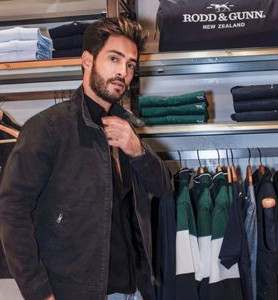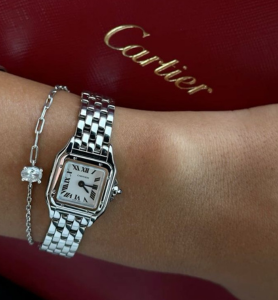Day four of New Zealand fashion week sees intimate collaborations alongside our local heavyweights returning to the runway
If there's one thing about New Zealand Fashion Week, it's that there's always sure to be surprises. Take last night's announcement, for instance, that NZFW will be heading south to Christchurch for a more condensed version of the programme. Take this morning's presentation at Jasmin Sparrow, where something beautiful is promised to be unveiled. Take the programme's most anticipated show, Karen Walker with her friends at adidas, returning to the NZFW runway for the first time in 15 years. It speaks to all those things we hold dear: celebrating our craftsmanship, our thoughtful lens, our staying power.
Join us as we head along to day four of NZFW.
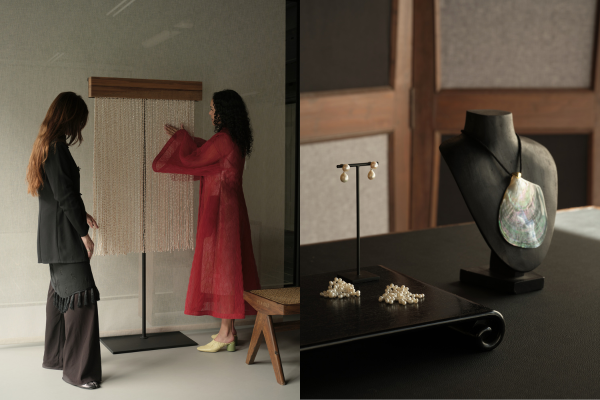
Images by Sam Hartnett.
Jasmin Sparrow
At Gallery Ne Guerra, jewellery designer Jasmin Sparrow and artist Jade Townsend staged something that sure, a presentation, but also a glimpse into an intimate conversation. A walled veil of pearls by Townsend set the tone—not static but tactile, designed to move and be touched—while Sparrow responded with body chains and long necklaces of pearls that could be worn across the body or folded back on themselves, silver hair pins (used to clink on a wine glass to catch everyone's attention) worn as more practical jewellery, pulling back hair, or perhaps pinning a shawl together. Together, the works asked where adornment ends and where object, memory, or art might begin.
The collaborative work, titled Siren, carried the pull of romance but also a quiet provocation: jewellery as something that can just as easily hang on a wall as around the body. Sparrow’s father built the stand on which the pieces were shown, grounding the exhibition in lineage and intimacy. Townsend’s practice, shaped by her Māori, Pākehā and British heritage, leans on stories, translation, and hybridity, while Sparrow’s strength has always been an easeful sensibility: jewellery that looks as though it has always belonged—to the world around it, to the person wearing it.
And so right now, in a moment where fashion is questioning permanence—what is collectible, what is lived with, what is passed down—Siren places jewellery in the wider conversation. Less accessory, more artefact. A reminder that material carries memory, and memory always demands to be held.
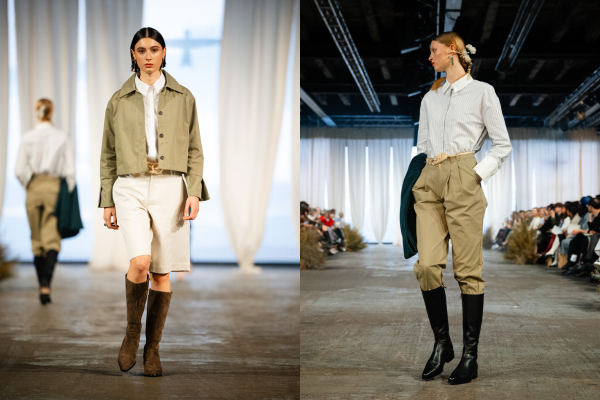
Images by Radlab.
Untouched World
Untouched World’s return to the runway felt less like a comeback and more like a quiet statement of intent. Rather than leaning on theatrics, the brand drew strength from its long-standing philosophy: clothes that live lightly on the earth while holding their place in the world of design.
The vision was inspired by nature’s quiet reclamation of space—plants pushing through cracks in the city—and that dialogue between the organic and the constructed shaped the silhouettes. Merino and linen came with equestrian leanings, trousers recalling jodhpurs tied with rope or scarf belts. Draped dresses layered over pleated skirts, knits were tossed over shoulders as if picked up en route. Scarves pinned with brooches, flowers tucked into plaits and pockets, and pendants that felt as practical as they were sculptural: these were clothes that invited you outside.
Textile was not just a talking point but the collection’s strongest visual statement. Here, Untouched World became the first in New Zealand to show Brewed Protein by Spiber, a sugarcane-derived fabric with the sheen of silk and the softness of cashmere. Seen alongside the brand’s considered merino and linen, the innovation underscored a larger message. When the models walked in unison, gathered behind curtain panels before emerging as one, the gesture resolved as something more than a finale: a vision of collective harmony. And might I be so bold to suggest, even a vision for a better world.
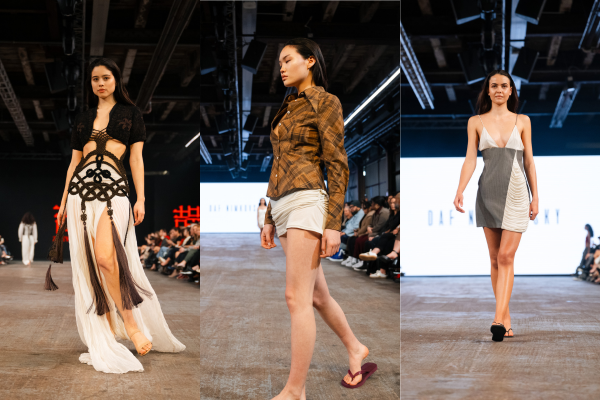
Images by Radlab.
Future of Fashion Showcase presented by DHL
At the Future of Fashion Showcase, presented by DHL, the mood was less graduation, more pressure test: how do emerging designers stake their claim in an industry already crowded with nostalgia, comfort, and subcultural references? The forces driving the global conversation right now found expression on a local stage, reminding us that the future of fashion isn’t hypothetical—it’s already in motion.
Bronwyn, who took the top prize, kept the focus firmly on footwear. Spotlit on plinths before being theatrically swept into shopping bags, her shoes were built on chunky, wearable heels, finished with organic textures and shell-like surfaces. The styling—tights as trousers, thigh-high warmers with open sandals—amplified the shoes’ presence without distracting from them. Gemma Lee, named runner-up, turned retro surf into a wardrobe. Wetsuits and floral swimsuits felt both ’70s and late-’90s, a knowing play on the cyclical nostalgia currently sweeping fashion.
Elsewhere, Riel reframed tailoring as leisurewear, shirts spliced and reimagined to the pulse of neon graffiti. Depth of Scye leaned into undone Victoriana, layering tartan, lace, and riveted leather with the precision of someone raised on punk. Too Cruel to Be Kind blurred rave and fantasy, Daf Nimkovsky worked drapery into sensual, lingerie-like forms, Zheyi Ruan let embroidered doilies fall like memory, and Ohn revelled in diva-coded pink.
Taken together, it was less a showcase than a provocation: comfort needn’t be boring, nostalgia can be a weapon, and deconstruction remains the language of the new.
Auckland FC x New Balance Kit Couture
Football fashion has always lived in a tension between utility and spectacle, and Auckland FC’s Kit Couture show with New Balance—an affair to launch the new uniforms for the club's sophomore season—leaned all the way into that push and pull. On one hand, there were hyper-technical fabrics, anoraks blown out to exaggerated proportions, and soccer ball quilting that teased at the sport’s most recognisable iconography. On the other, there were strange and witty gestures: a razor-straight tie against striped shorts, loafers set against jerseys, even a sudden bridal moment that reframed the supporter kit as ceremony. Star cameos, including club-owner Ali Williams among them, reminded the audience that this was still a football story, though retold through the grammar of street fashion. And what emerged was not simply a kit launch but a meditation on the way athletic wear is styled, consumed, and mythologised right now—where a club shirt can be as charged a cultural signifier as any It-bag.
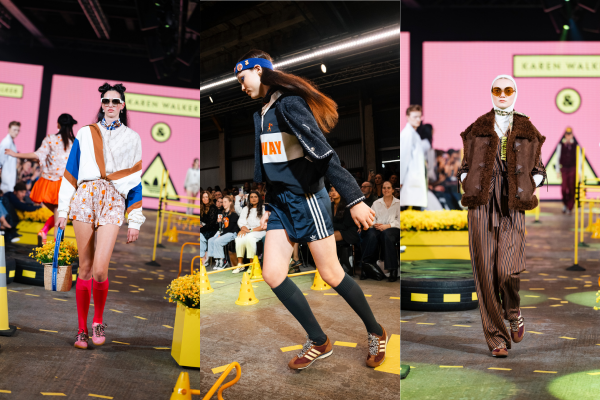
Images by Radlab.
Karen Walker & adidas
Life with Obstacles, the much-anticipated Karen Walker x adidas collaboration, marked Walker’s first return to the runway in 15 years—and she made sure it was anything but straightforward. Shed 10 was staged like a surreal playground: hurdles, cones, crates of flowers, even a treadmill in place of the catwalk. Theatrics set the tone, with models in lab coats fussing over the set before Walker’s iconic Runaway Girl logo flashed at the top of the runway, heralding the show’s start.
What followed was high-octane. Tracksuits were layered under velvet pea coats and letterman jackets, while puffball skirts in tech fabrics clashed with paisley prints and big bows on shirting. Balaclavas peeked out from shearling vests, hobbyhorses trotted past at speed, and woollen scarves tied into oversized bows recalled Walker’s wit. It was chaotic, joyful, unmistakably her—but sharpened by adidas Originals, some archival, some bespoke.
Hair, directed by Sara Allsop for Shark Beauty, carried the same spirit: diffused, textured, perfectly imperfect. More than a comeback, Walker’s runway return was a statement—life has obstacles, but fashion, she insists, should turn them into play.
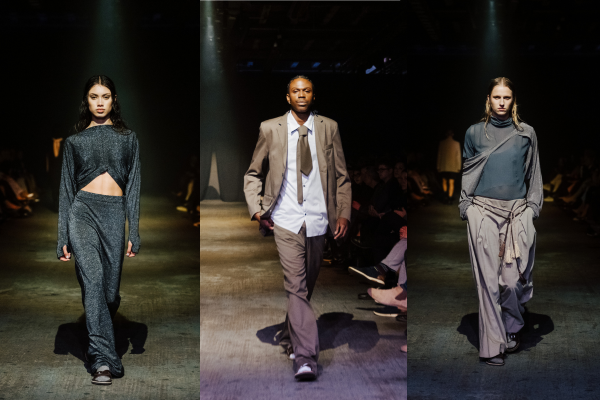
Images by Radlab.
Zambesi
Zambesi’s S26 collection, Instrumental, felt like watching the brand quietly redefine its own language. Long, soft coats draped like second skins, silk slips and linen with subtle sheen moved freely, while technical mesh appeared in kimono-like jackets that balanced precision with ease. Lace layered over pinstripe suits and pleated shirting introduced texture in unexpected places; undone ties, low belt loops, and curtain cords as belts suggested a confidence in imperfection.
Colour arrived in measured bursts—skinny neon belts, rainbow-hued panelled vests—and even floral prints felt deliberate rather than decorative. Footwear grounded the collection with a thoughtful tension: Roman sandals paired with Lurex socks, a quietly mischievous nod to history and modernity. Hair by Shark was soft, wet, and very undone, complementing the movement of fabric and lace without ever claiming attention.
The soundtrack amplified the emotional thread running through the show: extremes of vulnerability, joy, and quiet defiance. Every silhouette, every embellishment, felt like a personal gesture, as though the collection were built for people who value thoughtfulness and nuance over spectacle. Instrumental is not about announcing itself; it’s about the way it moves, the way it lingers, and the way it invites the wearer into its rhythm.



